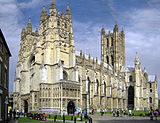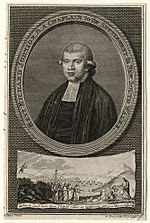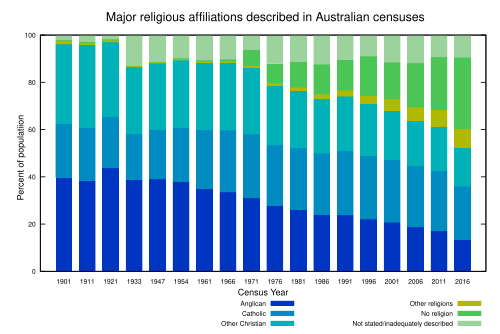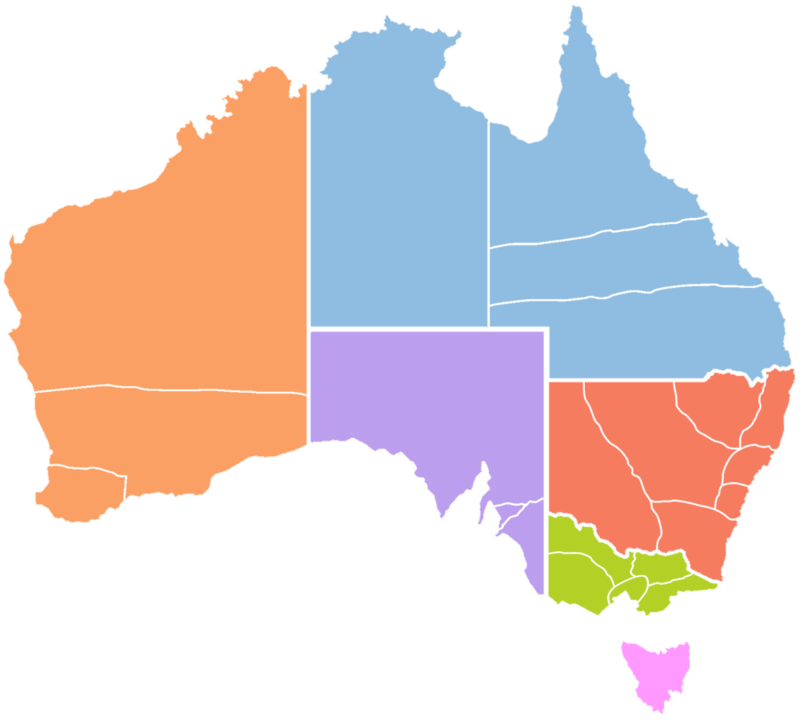Anglican Church of Australia
| Anglican Church of Australia | |
|---|---|
 | |
| Classification | Anglican |
| Orientation | Anglican |
| Polity | Episcopal |
| Headquarters | Brisbane, Queensland, Australia |
| Territory | Australia |
| Independence | 1962 |
| Official website | www.anglican.org.au |
| Part of a series on |
| Anglicanism |
|---|
 |
|
|
The Anglican Church of Australia is a member of the Anglican Communion. It is the second largest church in Australia, after the Roman Catholic Church.[2]
History


When the First Fleet was sent to New South Wales in 1787, Richard Johnson of the Church of England was licensed as chaplain to the Fleet and the settlement. In 1825 Thomas Scott was appointed Archdeacon of Australia under the jurisdiction of the Bishop of Calcutta. William Grant Broughton, who succeeded Scott in 1829, was consecrated the first (and only) "Bishop of Australia" in 1836.
In early Colonial times, the Church of England clergy worked closely with the governors. Richard Johnson, a chaplain, was charged by the governor, Arthur Phillip, with improving "public morality" in the colony, but he was also heavily involved in health and education.[4] Samuel Marsden (1765–1838) had magisterial duties, and so was equated with the authorities by the convicts. He became known as the "flogging parson" for the severity of his punishments.[5] Some of the Irish convicts had been transported to Australia for political crimes or social rebellion in Ireland, so the authorities were suspicious of Roman Catholicism for the first three decades of settlement and Roman Catholic convicts were compelled to attend Church of England services and their children and orphans were raised by the authorities as Anglicans.[6][7]
The Church of England lost its legal privileges in the Colony of New South Wales by the Church Act of 1836. Drafted by the reformist attorney-general John Plunkett, the act established legal equality for Anglicans, Roman Catholics and Presbyterians and was later extended to Methodists.[8]
A mission to the Aborigines was established in the Wellington Valley in New South Wales by the Church Missionary Society in 1832, but it ended in failure and indigenous people in the 19th century demonstrated a reluctance to convert to the religion of the colonists who were seizing their lands.[9]
In 1842 the Diocese of Tasmania was created. In 1847 the rest of the Diocese of Australia was divided into the four separate dioceses of Sydney, Adelaide, Newcastle and Melbourne. Over the following 80 years the number of dioceses increased to 25.

Sectarianism in Australia tended to reflect the political inheritance of Britain and Ireland. Until 1945, the vast majority of Roman Catholics in Australia were of Irish descent, causing the Anglo-Protestant majority to question their loyalty to the British Empire.[7] The Australian Constitution of 1901 provided for freedom of religion. Australian society was predominantly Anglo-Celtic, with 40% of the population being Anglican. It remained the largest Christian denomination until the 1986 census. After World War II, the ethnic and cultural mix of Australia diversified and Anglicanism gave way to Roman Catholicism as the largest denomination. The number of Anglicans attending regular worship began to decline in 1959 and figures for occasional services (baptisms, confirmations, weddings and funerals) started to decline after 1966.[9] In recent times, the Anglican and other Christian churches of Australia have been active in ecumenical activity. The Australian Committee for the World Council of Churches was established in 1946 by the Anglican and mainline Protestant churches. The movement evolved and expanded with Eastern and Oriental Orthodox churches later joining and by 1994 the Roman Catholic Church was also a member of the national ecumenical body, the National Council of Churches in Australia.
Since 1 January 1962 the Australian church has been autocephalous and headed by its own primate. On 24 August 1981 the church officially changed its name from the Church of England in Australia to the Anglican Church of Australia.[10]
Although the Book of Common Prayer remains the official standard for Anglican belief and worship in Australia, An Australian Prayer Book (AAPB) was published in 1978 after a prolonged revision of liturgy. Another alternative service book, A Prayer Book for Australia (APBA), was published in 1995.[9]
In 1985 the general synod of the Australian church passed a canon to allow the ordination of women as deacons. In 1992 the general synod approved legislation allowing dioceses to ordain women to the priesthood. Dioceses could choose to adopt the legislation. In 1992, 90 women were ordained in the Anglican Church of Australia and two others who had been ordained overseas were recognised.[11] After decades of debate the issue of women's ordination, particularly as bishops, continues to divide traditionalists and reformers within the church. By November 2013 five dioceses had not ordained women as priests and two had not ordained women as deacons.[12][13][14] The most recent diocese to vote in favour of ordaining women as priests was the Ballarat diocese in October 2013.[15] In 2008, Kay Goldsworthy was ordained as an assistant bishop for the Diocese of Perth, thus becoming the first female bishop of the Anglican Church of Australia.[16] Sarah Macneil was elected in 2013 to be the first female diocesan bishop in Australia.[17] In 2014 she was consecrated and installed as the first female diocesan bishop in Australia (for the Diocese of Grafton in New South Wales).[18]
The church remains a major provider of education and welfare services in Australia.[19] It provides chaplains to the Australian Defence Force, hospitals, schools, industry and prisons.[9] Senior clergy such as Peter Jensen, former Archbishop of Sydney, have a high profile in discussions on a diverse range of social issues in contemporary national debates.[20] In recent times the church has encouraged its leaders to talk on such issues as indigenous rights; international security, peace and justice; and poverty and equity.[21] The current primate is Philip Freier, Archbishop of Melbourne, who took office on 4 July 2014.[1]
Like other religious groups, the church has come under criticism in light of cases of sexual abuse by clergy and others.[22][23]
The Anglican Church of Australia, during the annual meeting of the House of Bishops in Melbourne in March 2012, reaffirmed its stance on homosexuality and non-celibate homosexual clergy. The bishops stated that they "accept the weight of 1998 Lambeth Resolution 1.10 and the 2004 General Synod resolutions 33, 59 and 61-64 as expressing the mind of this church on issues of human sexuality." They also "undertake to uphold the position of our Church in regard to human sexuality as we ordain, license, authorise or appoint to ministries within our dioceses" and "understand that issues of sexuality are subject to ongoing conversation within our Church and we undertake to support these conversations, while seeking to maintain the unity of the Spirit in the bond of peace." A spokesman for the Primate, Phillip Aspinall, stated that "In effect it is an undertaking not to ordain, license, authorise or appoint persons whom the bishop knows to be in a sexual relationship outside of marriage."[24]
Demographics and structure

Until the 1986 census, Australia's most populous Christian church was the Anglican Church of Australia. Since then Roman Catholics have outnumbered Anglicans by an increasing margin. One rationale to explain this relates to changes in Australia's immigration patterns. Prior to the Second World War, the majority of immigrants to Australia had come from the United Kingdom - though most of Australia's Roman Catholic immigrants had come from Ireland. After World War II, Australia's immigration program diversified and more than 6.5 million migrants arrived in Australia in the 60 years after the war, including more than a million Roman Catholics.
Census data shows that as a percentage of population Anglican affiliation peaked in 1921 at 43.7%, and the number of persons indicating Anglican affiliation peaked in 1991 at 4 million. In the 2011 there were 3,679,907 Anglicans, representing 17.1 per cent of the population. (See accompanying graph.)
The Australian church consists of twenty-three dioceses arranged into five provinces (except for Tasmania) with the metropolitical sees in the states' capital cities. Broughton Publishing is the church's national publishing arm.[25]
| State/Territory [26] | % 2011 | % 2006 | % 2001 |
|---|---|---|---|
| Australian Capital Territory | 14.7 | 16.7 | 18.5 |
| New South Wales | 19.9 | 21.8 | 23.8 |
| Northern Territory | 11.4 | 12.3 | 14.7 |
| Queensland | 18.9 | 20.4 | 22.5 |
| South Australia | 12.6 | 13.7 | 15.2 |
| Tasmania | 26.0 | 29.3 | 32.4 |
| Total | 17.1 | 18.7 | 20.7 |
| Victoria | 12.3 | 13.6 | 15.3 |
| Western Australia | 18.8 | 20.4 | 22.6 |
Society, arts and culture
Welfare and education
Anglicans have played a prominent role in welfare and education since Colonial times, when First Fleet chaplain Richard Johnson was credited by one convict as "the physician both of soul and body" during the famine of 1790 and was charged with general supervision of schools.[4] Today the church remains a significant provider of social welfare with organisations working in education, health, missionary work, social welfare and communications. Welfare organisations include Anglicare and Samaritans. There are around 145 Anglican schools in Australia, providing for more than 105,000 children.[19] Church schools range from low-fee, regional and special needs schools to high-fee leading independent schools like Geelong Grammar, whose alumni include Prince Charles and Rupert Murdoch; and Sydney's The Kings School. The Australian Anglican Schools Network is the national schools network of the Australian General Synod.[27]
Architecture

The first Church of England edifice was built in the colony of New South Wales in 1793.[28] Today, most towns in Australia have at least one Christian church. One of Australia's oldest Anglican churches is St James' Church in Sydney, built between 1819 and 1824. The historic church was designed by Governor Macquarie's architect, Francis Greenway - a former convict - and built with convict labour. The church is set on a sandstone base and built of face brick with the walls articulated by brick piers.[29] Sydney's Anglican cathedral, St Andrew's, was consecrated in 1868 from foundations laid in the 1830s. Largely designed by Edmund Thomas Blacket in the Perpendicular Gothic style reminiscent of English cathedrals. Blacket also designed St Saviour's Cathedral in Goulburn, based on the Decorated Gothic style of a large English parish church and built between 1874-1884.[30]
St Paul's Cathedral, Melbourne, from a foundation stone laid in 1880, is a Melbourne landmark. It was designed by the distinguished English architect William Butterfield in Gothic Transitional.[31]
Tasmania is home to a number of significant colonial Anglican buildings including those located at Australia's best preserved convict era settlement, Port Arthur. According to 19th century notions of prisoner reform, the Model Prison incorporates a grim chapel, into which prisoners in solitary confinement were shepherded to listen (in individual enclosures) to the preacher's Sunday sermon - their only permitted interaction with another human being.[32] Adelaide, the capital of South Australia has long been known as the City of Churches and its St Peter's Anglican Cathedral is a noted city landmark.[33]
The oldest building in the city of Canberra is the picturesque St John the Baptist Church in Reid, consecrated in 1845. This church long predates the city of Canberra and is not so much representative of urban design as it is of the Bush chapels which dot the Australian landscape and stretch even into the far Outback.
A number of notable Victorian era chapels and edifices were also constructed at church schools across Australia. Along with community attitudes to religion, church architecture changed significantly during the 20th century.
Provinces and dioceses

The whole church is led by the elected Primate, Philip Freier, Archbishop of Melbourne. The provinces and dioceses are listed with each diocese's bishop or archbishop:
- Province of Victoria (Metropolitan: Philip Freier, Archbishop of Melbourne)
- Gippsland (Kay Goldsworthy)
- Wangaratta (John Parkes)
- Melbourne (Archbishop: Philip Freier)
- Bendigo (Andrew Curnow)
- Ballarat (Garry Weatherill)
- Province of South Australia (Metropolitan: Jeffrey Driver, Archbishop of Adelaide)
- The Murray (John Ford)
- Adelaide (Archbishop: Jeffrey Driver)
- Willochra (John Stead)
- Province of New South Wales (Metropolitan: Glenn Davies, Archbishop of Sydney)
- Sydney (Archbishop: Glenn Davies)
- Canberra and Goulburn (Stuart Robinson)
- Riverina (Vacant. Administrator: Edwin Byford, Rector of Deniliquin.[34] Bishop-elect: Rob Gillion[35])
- Bathurst (Ian Palmer)
- Newcastle (Greg Thompson)[36]
- Armidale (Rick Lewers)
- Grafton (Sarah Macneil.[37])
- Province of Queensland (Metropolitan: Phillip Aspinall, Archbishop of Brisbane)
- Brisbane (Archbishop: Phillip Aspinall)
- Rockhampton (Vacant. Bishop-elect: David Robinson)
- North Queensland (Bill Ray)
- Northern Territory (Vacant. Bishop-elect: Greg Anderson)
- Province of Western Australia (Metropolitan: Roger Herft, Archbishop of Perth)
- North West Australia (Gary Nelson)
- Perth (Archbishop: Roger Herft)
- Bunbury (Allan Ewing)
- Extraprovincial diocese
Map of dioceses
| KEY to province colours | New South Wales | Victoria | Queensland | Western Australia | South Australia | Extraprovincial |
See also
References
- ^ a b Melbourne Archbishop to lead Australian Anglican Church, 29 June 2014 (Accessed 30 June 2014)
- ^ "Census vs Attendance (2001)". National Church Life Survey.
- ^ "Cultural diversity". 1301.0 - Year Book Australia, 2008. Australian Bureau of Statistics. 2008-02-07. Archived from the original on 13 February 2010. Retrieved 2010-02-15.
{{cite web}}: Unknown parameter|deadurl=ignored (|url-status=suggested) (help) - ^ a b K. J. Cable. "Johnson, Richard (1753? - 1827) Biographical Entry - Australian Dictionary of Biography Online". Adbonline.anu.edu.au. Retrieved 2013-07-10.
- ^ A. T. Yarwood. "Marsden, Samuel (1765 - 1838) Biographical Entry - Australian Dictionary of Biography Online". Adbonline.anu.edu.au. Retrieved 2013-07-10.
- ^ "Catholic Encyclopedia: Australia". Newadvent.org. Retrieved 2013-07-10.
- ^ a b "The Catholic Community in Australia". Catholic Australia. Retrieved 2013-07-10.
- ^ T. L. Suttor. "Plunkett, John Hubert (1802 - 1869) Biographical Entry - Australian Dictionary of Biography Online". Adbonline.anu.edu.au. Retrieved 2013-07-10.
- ^ a b c d [1][dead link]
- ^ When did the Church of England become the Anglican Church of Australia?[dead link]
- ^ Anglican Church of Australia website.
- ^ http://www.oikoumene.org/en/member-churches/anglican-church-of-australia
- ^ "Bishops ruling shatters stained glass ceiling". The Sydney Morning Herald. 2007-09-29.
- ^ http://www.thecourier.com.au/story/1851730/ballarat-anglican-church-approves-women-priests/?cs=61
- ^ The Courier newspaper online.
- ^ Davies, Matthew (2008-04-11). "Australia appoints first woman bishop". Episcopalchurch.org. Retrieved 2010-11-19.
- ^ http://episcopaldigitalnetwork.com/ens/2013/11/18/australia-sarah-macneil-appointed-first-female-diocesan-bishop/
- ^ http://www.anglicannews.org/news/2014/03/australias-first-woman-diocesan-bishop-consecrated.aspx
- ^ a b About Australia: Religious Freedom[dead link]
- ^ "Anglican Archbishop of Sydney: Peter Jensen :: Sunday Profile". Abc.net.au. Retrieved 2013-07-10.
- ^ [2][dead link]
- ^ Rowland Croucher. "'God Wants You To Love Me' (Sexual Abuse In The Anglican Church) | John Mark Ministries". Jmm.aaa.net.au. Retrieved 2013-07-10.
- ^ Amelia Bentley (2009-04-24). "Priest admits sex abuse of altar boys". Brisbanetimes.com.au. Retrieved 2013-07-10.
- ^ ""Gay clergy banned in Australia", ''The Church of England Newspaper'', 22 April 2012, p. 7". Geoconger.wordpress.com. Retrieved 2013-07-10.
- ^ "Contact Us". Broughton Publishing. Retrieved 2 November 2014.
- ^ http://www.abs.gov.au/websitedbs/censushome.nsf/home/quickstats?opendocument&navpos=220
- ^ "Australia: Schools and Education". Anglicans Online. 2013-06-14. Retrieved 2013-07-10.
- ^ [3][dead link]
- ^ "Heritage Branch Website - Online Database". Heritage.nsw.gov.au. 2013-06-27. Retrieved 2013-07-10.
- ^ "History". Goulburncathedral.org.au. Retrieved 2013-07-10.
- ^ [4][dead link]
- ^ "Australian Convict Site & Attractions near Hobart Tasmania". Port Arthur. 2013-05-13. Retrieved 2013-07-10.
- ^ Welcome | St Peter’s Cathedral
- ^ Diocese of Riverina, "The Bishop", http://www.anglicanriverina.com/?D=49
- ^ Former British actor elected bishop in Australia, http://anglicanink.com/article/former-british-actor-elected-bishop-australia
- ^ http://www.theherald.com.au/story/2061418/new-anglican-bishop-promises-justice-compassion.
- ^ "Anglicans Elect First Woman Bishop", news.com.au.
Further reading
- Blombery, Tricia The Anglicans in Australia
- Breward, Ian A History of the Australian Churches
- Bunting, Ian (ed), Celebrating the Anglican Way
- Davis, John Australian Anglicans and their Constitution
- Elkin, A. P. The Diocese of Newcastle: a history
- Harris, John One Blood
- Hilliard, David Godliness & Good Order: a history of the Anglican Church in South Australia
- Judd, Stephen & Cable, Kenneth Sydney Anglicans
- Kaye, Bruce A Church Without Walls
- Porter, Brian (ed), Melbourne Anglicans
- Porter, Muriel Women in the Church: the great Ordination debate in Australia
- Porter, Muriel The new puritans: the rise of fundamentalism in the Anglican Church Carlton, Victoria: Melbourne University Publishing, 2006 ISBN 0522851843
External links
- Anglican Church of Australia - official website
- Anglican Communion: Anglican Church of Australia


